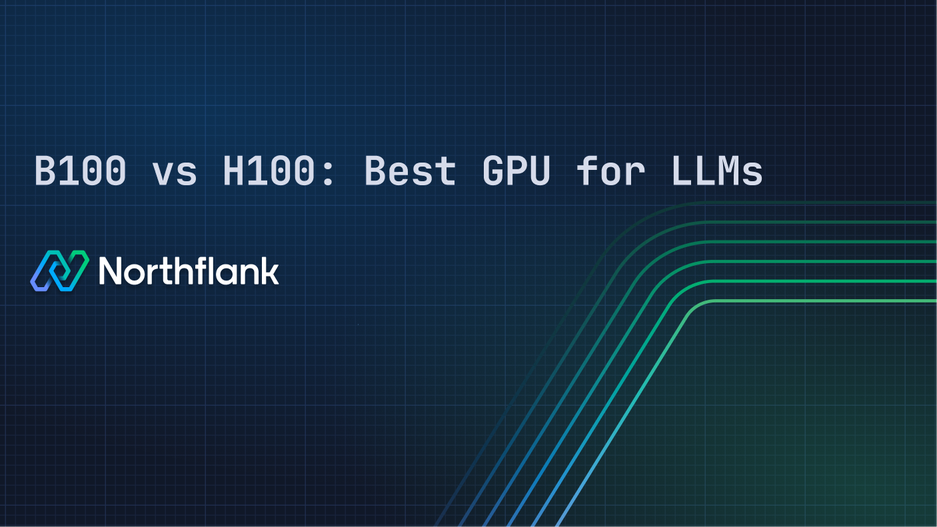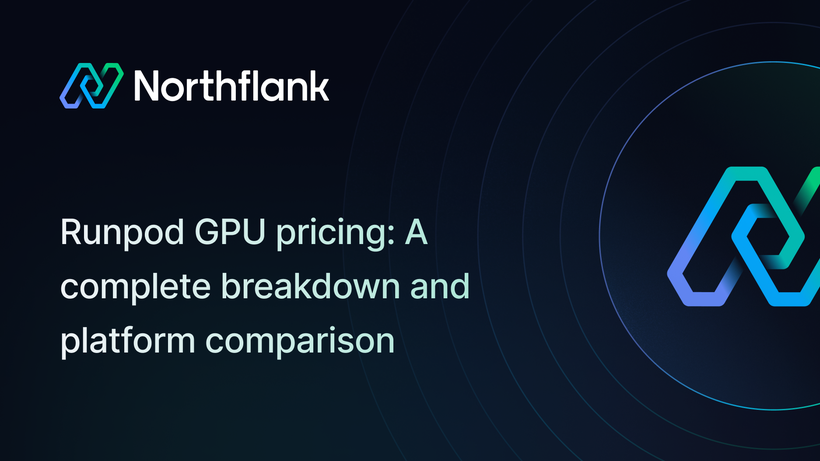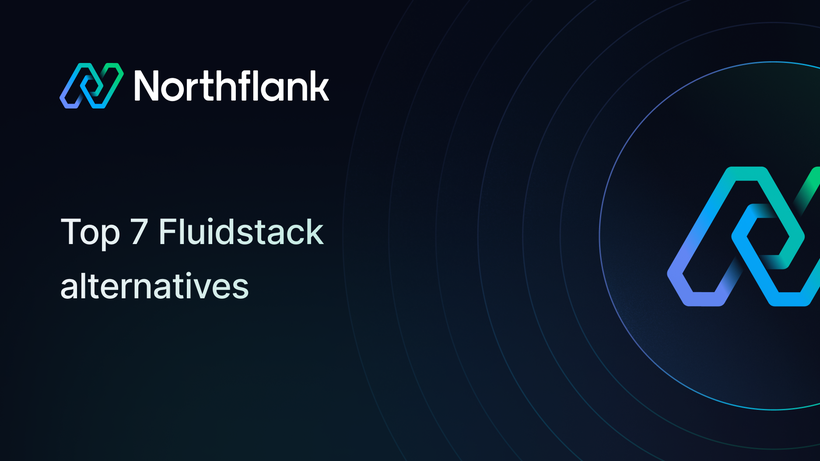

B100 vs H100: Best GPU for LLMs, vision models, and scalable training
The H100 is still one of the most trusted GPUs for building and running large AI models. It’s been the go-to for teams shipping fine-tuned LLMs, scalable inference, and training pipelines that just need to work.
NVIDIA’s new B100 steps things up for teams training larger models or scaling across dense clusters. With faster memory, improved interconnects, and a new architecture, it’s designed for workloads pushing the edge of what’s possible.
This guide breaks down how the two compare across architecture, workloads, and performance so you can decide which one fits your stack. If you're running AI in production or planning to, Northflank gives you fast access to the right GPUs, without long-term commitments, at affordable prices.
If you're short on time, here’s how the B100 and H100 compare side by side:
Note on B100 availability: The B100 has limited availability across most cloud providers. If you have specific requirements for Blackwell architecture GPUs, request GPU capacity here to explore your options.
| Feature | H100 | B100 |
|---|---|---|
| Architecture | Hopper | Blackwell |
| Tensor Cores | 4th Gen + Transformer Engine | 5th Gen + Dual Transformer Engines |
| Memory Type | HBM3 | HBM3e |
| Max Bandwidth | ~3.35 TB/s | ~4.8 TB/s |
| FP8 Support | Yes | Yes (improved) |
| NVLink | 900 GB/s | NVLink 5 (1.8 TB/s node-to-node) |
| Form Factors | PCIe, SXM | SXM (NVLink-focused) |
| Transformer Optimization | Yes | Yes (faster context window support) |
| Target Workloads | LLMs, fine-tuning, training | Foundation model training, ultra-large scale inference |
| Cost on Northflank (July 2025) | 80GB VRAM - $2.74/hr | NA |
💭 What is Northflank?
Northflank is a full-stack AI cloud platform that helps teams build, train, and deploy models without infrastructure friction. GPU workloads, APIs, frontends, backends and databases run together in one place so your stack stays fast, flexible, and production-ready.
Sign up to get started or book a demo to see how it fits your stack.
The B100 is onee of NVIDIA’s most powerful GPUs yet. It uses the new Blackwell architecture and was built specifically for frontier-scale workloads. While the H100 pushed AI hardware into the fine-tuning era, the B100 is meant for foundation model training and large-scale inference.
The real upgrades come from the fifth-generation tensor cores and dual transformer engines. This gives it better throughput in FP8 workloads, which are becoming the new standard for model training. Paired with HBM3e memory and NVLink 5, the B100 can scale across nodes faster than anything before it.
This makes it a strong fit for training trillion-parameter models, extending context windows in LLMs, or experimenting with multi-modal architectures that demand more memory and compute.
Most teams today are still shipping with H100, and for good reason. Built on the Hopper architecture, it brought major gains in inference performance, introduced FP8 support, and made training more efficient without changing model code.
The H100 runs well in most cloud environments, thanks to support for both PCIe and SXM form factors. It offers high bandwidth through HBM3 memory and supports the software stacks that teams already use.
For anyone running high-throughput inference, fine-tuning open models, or distributing workloads across many GPUs, the H100 still delivers where it matters. It remains the most accessible GPU for teams that need flexibility and stability.
Now that we’ve looked at how the B100 and H100 perform on their own, it’s worth breaking down what actually makes them different. The two GPUs aren’t just built for different generations of hardware; they reflect a shift in how teams train and scale deep learning models. Here's how they stack up across architecture, memory, precision, and deployment.
The H100 introduced transformer engines and FP8 to mainstream AI workflows. The B100 builds on that with dual transformer engines and newer tensor cores, allowing more parallelism across tokens and layers. This matters for models with long context lengths or those doing more compute per step.
B100 uses faster HBM3e memory, giving it about 40% more bandwidth than the H100. It also uses NVLink 5, which doubles node-to-node communication speeds. For distributed training or multi-GPU setups, this makes B100 significantly more capable at scale.
Both chips support FP8, but B100’s implementation is more efficient. If you're training models from scratch or pushing new architectures, B100 handles mixed-precision workloads with less overhead and better convergence.
H100’s dual format (PCIe and SXM) works well across clouds and on-prem environments. B100 is SXM-only and optimized for NVLink-based clusters. If you're running dense workloads with lots of parallelism, B100 fits better. But for most production inference or hybrid cloud use cases, H100 remains more flexible.
B100 requires newer CUDA versions (12.4 and above) and gets the most from updates like cuDNN 9. If your stack is already running H100s, upgrading to B100 might involve more software work, but the performance upside is significant.
The best look we have at B100 performance comes from NVIDIA's MLPerf Training submissions using the HGX B200 platform. Since both B100 and B200 use the Blackwell architecture, these results are a solid proxy.
Compared to H100, Blackwell GPUs delivered major per-GPU speedups in every category. GPT-3 pre-training ran 2 times faster, Llama 2 70B fine-tuning showed a 2.2 times gain, and even workloads like image generation and recommendation systems saw clear improvements.
| Workload | Speedup |
|---|---|
| GPT-3 Pre-training | 2.0× |
| Llama 2 70B LoRA fine-tuning | 2.2× |
| Graph neural networks | 2.0× |
| Text-to-image generation | 1.7× |
| Recommenders | 1.6× |
| Object detection | 1.6× |
| BERT training | 1.4× |
These results also came from smaller GPU counts. The GPT-3 benchmark ran with just 64 Blackwell GPUs compared to 256 H100s for similar per-GPU performance.
At Northflank, we offer access to H100 and other GPUs like the B200. The B100 is not currently supported on our platform, as supply remains constrained industry-wide.
As of July 2025, GPU pricing on Northflank looks like this:
- A100 40GB: $1.42/hr
- A100 80GB: $1.76/hr
- H100 80GB: $2.74/hr
- H200 141GB: $3.14/hr
- B200 180GB: $5.87/hr
The H100 offers the best value for teams doing fine-tuning or deployment. While it costs more than A100, it can reduce training time and improve model performance, especially on larger tasks.
Start training on H100 with Northflank
If your workloads are centered on production inference, fine-tuning open-source models, or cost-efficient training, H100 is still the best overall choice. It’s battle-tested, well-supported, and scales cleanly across environments.
The B100 makes sense when you're building for the next generation of AI models, particularly when you need longer context lengths, more tokens per batch, or deeper model architectures. Just keep in mind that availability is limited, and adoption might lag behind other Blackwell GPUs like the B200.
| Use Case | Recommended GPU |
|---|---|
| Fine-tuning LLMs | H100 |
| Large context transformers | B100 |
| Cost-optimized inference | H100 |
| Foundation model training | B100 |
| Multi-GPU scaling with NVLink | B100 |
| On-prem & hybrid cloud setups | H100 |
The B100 brings a real shift in how frontier-scale models can be trained, but it may not be the right GPU for everyone just yet. It’s faster, more scalable, and built for new model classes, but not yet widely available or fully supported across the ecosystem.
If you're already building with the H100 and need stability, flexibility, and performance, there's no urgency to move. But if you're planning for the next leap in model scale, the B100 is worth watching closely.
At Northflank, we help teams run production-grade AI workloads using hardware that’s available right now. You can launch GPU instances in minutes or book a quick demo to see how it fits into your stack.


